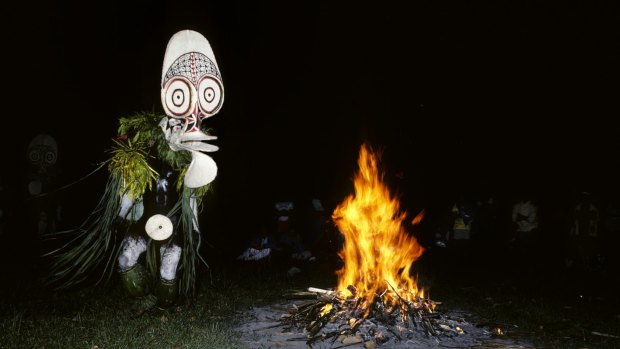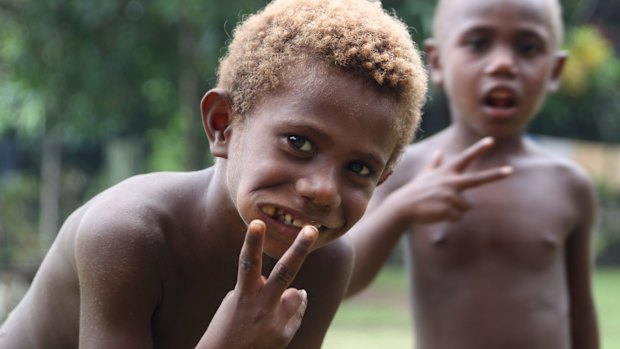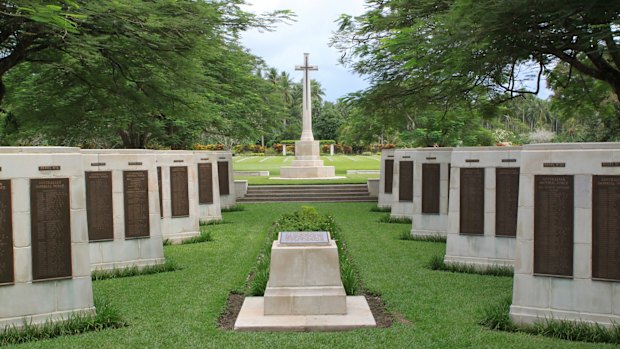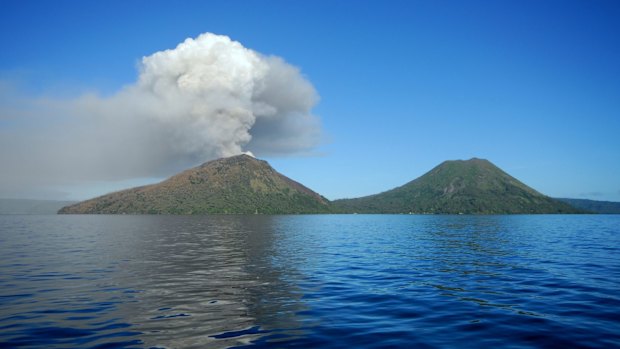This was published 9 years ago
Papua New Guinea: The hypnotic ritual on our doorstep

Baining dancers Rabaul.Credit: Getty Images
There's a rhythmic thump rising from the darkness, a deep cadence that echoes among the trees. It's been going for some time now – thump, thump, thump; low and powerful, shaking the ground – as we huddle in the clearing and wait for the action to begin.
Soon the thump is joined by men's voices, chants that blend with those deep vibrations, songs that haunt the night air and signal to the tribe, to the dancers, to the onlookers, to the gods: it's time to begin.
A murky shape moves in the darkness, approaching the pyre in the centre of the clearing. There's a small spark as the sticks and leaves are set alight, and then flames lick the humid air as the fire quickly becomes an inferno that lights the trees around us with dancing shadows.

Kids chewing betel nut in Maira.Credit: Ben Groundwater
The thump of wood on wood continues. The chanting rises. It builds slowly towards a crescendo.
And then it happens. Out of the darkness a huge shape moves, tearing out of the forest and into the light of the fire. Then there's another, and then another, until there are 13, 14, maybe 15 masked figures out there in the clearing. Their legs and torsos are human, but their heads are huge and otherworldly, with large beaks and giant eyes gazing wildly around.
Eventually those unblinking pupils all focus on the fire in the middle of the circle. The figures begin darting in towards the flames and then out again, in and out, building up their confidence, daring each other to go closer, until eventually one runs all the way in and kicks at the flames, sending a shower of sparks into the night sky.

Australian War Memorial at Bitapaka.Credit: Ben Groundwater
Soon another figure has done the same, and another, and another. Sparks fly; onlookers gasp. One of the masked men stands for a second in the middle of the bonfire, almost engulfed by flames, looking godly and frightening, before he runs away into the safety of the jungle.
And the ceremony continues. This is an initiation for young members of the Baining tribe; a bizarre ritual of celebration and obeisance. Men kick wildly at the flames. Embers burn the night sky. The chants and thumping of wood on wood rumbles around. And the strangest thing occurs to me.
This traditional fire dance is being performed in the heart of northern Papua New Guinea. It's a rare glimpse of a little-known ritual. But it's not the witnessing of the spectacle that moves me. It's not those deep chants or the showers of sparks or the ghoulish heads and singed limbs of the dancers. It's not the isolation. It's not the danger.

Mount Tavurvur.Credit: Getty Images
It's the realisation that all of this is happening so close to home. This entire ritual, wild and perilous and unusual, is taking place so near to the safety and familiarity of Australia. About a two-hour flight away, people are sipping sauvignon blanc and tossing up whether to order the grilled barramundi in some restaurant in Cairns, and here we are deep in a forest watching as masked men take on fire and gods in an ancient tribal display.
It's incredible. People travel to far-flung parts of Africa to see this sort of thing. They go deep into the Amazon. And it's happening just across Torres Strait. Amazing.
Somewhere off in the distance, the hum of a generator starts up. One of the village chiefs raises his eyebrows. "Someone," he says, "is charging his phone, I think."
Things aren't always as they seem around here. We might be completely isolated in a tiny island village, the sort of place where grass grows high on the footy pitch and chickens roam free among the vegie gardens and wooden huts, but there are still surprising intrusions of the modern world. Most people on Mioko Island seem to have mobile phones. They live on a largely subsistence basis, but there's room for modern distractions.
Today, we're one of those distractions. We've come to spend the night at Maira, a village on Mioko Island, about a two-hour trip in a fibreglass banana boat from Kokopo. Kokopo is what counts as the "big smoke" around here – it's the capital of the province, East New Britain, and the base from which I've come to experience the Baining fire dancers, as well as the surrounding islands.
Just getting to Mioko from Kokopo was an experience I will never forget. A day after arriving in PNG, my group of fellow travellers and I piled into a banana boat and headed out to sea. We'd been told there were sometimes spinner dolphins in the area, and to keep a lookout for fins. Maybe we'd see three or four, we thought. Or a large pod of five or six.
We were about an hour off the coast, getting in towards the Duke of York islands, when we spotted them: a sea of dorsal fins, a seething mass of mammalian life. There must have been 100 dolphins out there, some surfing the swell at the front of our boat, others leaping high into the air and crashing back into the ocean with a splash.
Pretty soon we'd donned masks and snorkels and jumped into the clear ocean with them, hanging on to a rope as the boat cruised through this huge pod and the dolphins darted in and out, checking out these weird creatures flapping around in the water, playing in the wake, ducking and diving all around us.
It was one of those experiences you never think you'll actually have: swimming in warm tropical waters, the feeling of isolation from the real world complete, as hundreds of wild dolphins jump and play nearby.
It had to end, of course. There came a time when we had to climb back into the boat and continue motoring towards Mioko, to the village of Maira, to our home for the night.
The idea is that this will be a window into another life. There are no hotels in Maira. No commercial entities at all. There's little to do but stroll around and observe the place, to sit with a group of women as they weave mats, to throw a footy around with some of the kids, to rest under a tree and drink from fresh coconuts. Locals say hello as they walk past, smiling bright red smiles, their teeth stained by betel nut. Kids sit and stare and poke each other and laugh.
There's an almost mystical quality to the whole island, a feeling that only deepens when you find out that black magic is still practised sometimes in these parts. Shells are used here as currency. It's so different, and yet so close.
There's something of a rivalry between the towns of Rabaul and Kokopo. After Mount Tavurvur erupted in 1994, covering Rabaul in a thick blanket of ash, the capital of East New Britain was shifted to Kokopo, and much of the local population went with it. Those residents who have tenaciously clung on to their businesses and their lives in Rabaul still resent the shift, but you get the feeling they're fighting a losing battle.
One of those fighters is Susie McGrade, the owner and manager of Rabaul Hotel. Susie's family has lived here since her grandfather came over as a prospector. These days she still has to regularly sweep ash off the roof of her hotel, but somehow it remains open, even in the shadow of Mount Tavurvur; and somehow the guests keep trickling in.
They arrive here for the same reason we do, because Rabaul has already seen its fair share of battles. In World War II the town had more bombs dropped on it than Pearl Harbour. It was a battleground between the Allied Forces and Japan, a point of strategic importance.
There are still more than 2000 kilometres of tunnels snaking through the earth beneath our feet. The war bunker once used by Admiral Isoroku Yamamoto, the architect of the attack on Pearl Harbour, remains open to tourists.
The rest of Rabaul has a ghostly, apocalyptic feel – much of it is still covered in ash; many buildings are skeletal ruins. Though the town functions as a working port and marketplace, there aren't many true residents left.
Soon, even our group of travellers has departed. We're back in the minivan, heading up into the highlands behind Kokopo as the sun begins to set, bound for a Baining village deep in the jungle. There, the tribesmen are preparing to perform their ritual fire dance.
Right now they're putting the finishing touches on huge masks made of bamboo and soft bark. They're painting their skin. They're tying on skirts of pandanus leaves. They're waiting to feel the thud of wood on wood, to hear the chants of their fellow men, to see the flames rising high in the clearing.
Then, the ceremony will begin.
The writer travelled as a guest of the Papua New Guinea Tourism Promotion Authority.
TRIP NOTES
MORE INFORMATION
www.papuanewguinea.travel/australia
GETTING THERE
Air Niugini flies to Kokopo, via Port Moresby, from Sydney, Brisbane and Cairns. See www.airniugini.com.pg.
STAYING THERE
Rapopo Plantation Resort in Kokopo has modern, comfortable rooms right on the beachfront. Garden rooms start from PGK450. See www.rapopo.com.
SEE + DO
The Maira Homestay on Mioko Island (from PGK788) and the Baining fire dance ceremony can both be booked through the Kokopo Beach Bungalow Resort. See www.kbb.com.pg. Scuba diving in Kokopo is done by Kabaira Dive: www.diveandtoursrabaul.com. Tours of Rabaul are conducted by Kokopo Tours. See www.kokopotours.net.
FIVE MORE AMAZING PNG EXPERIENCES
MASK FESTIVAL
Each year in July, tribes from all over Papua New Guinea gather in Kokopo to show off their culture, often in the form of dances and rituals paired with some of the most amazing costumes you've ever seen. Keep an eye out for the Baining fire dancers, who usually perform.
DIVING MILNE BAY
The scuba-diving in Milne Bay, in the far east of PNG, might just be the best around. Here you'll find spectacular underwater worlds that are almost completely untouched by man – these warm waters are shared only with manta rays, eels, sharks, and abundant fish life.
BOUGAINVILLE
One of the great things about Bougainville – a province with a troubled past, but a bright future – is that as a tourist you have it almost to yourself. There's little infrastructure and very few visitors, but the attractions, including forest hikes, snorkelling, and World War II wrecks, make it worth the journey.
KOKODA TRACK
This famed pathway used by the Australian Army during the war continues to grow in popularity as a tourist attraction. The nine-day hike through the heart of PNG is certainly not easy, but it's historically very important, and the scenery is amazing.
MT HAGEN CULTURAL SHOW
Similar to the Mask Festival in Kokopo, this is another annual "singsing", or cultural gathering, involving more than 100 tribes from around PNG. The tribespeople come to share their culture and traditions, which often manifests itself in colourful costumes and body paint.
Sign up for the Traveller Deals newsletter
Get exclusive travel deals delivered straight to your inbox. Sign up now.